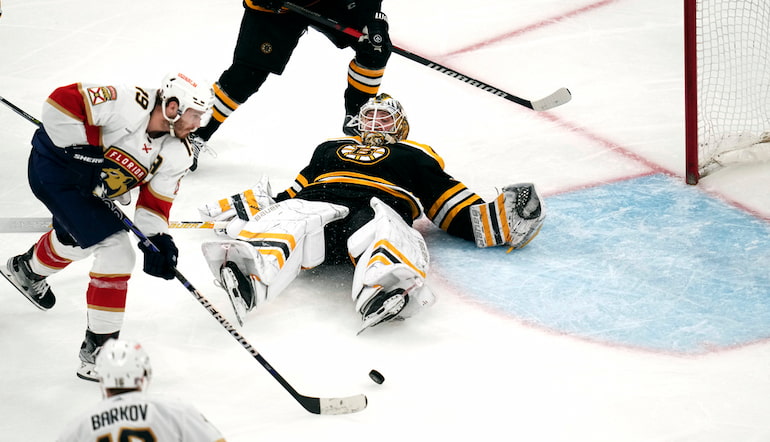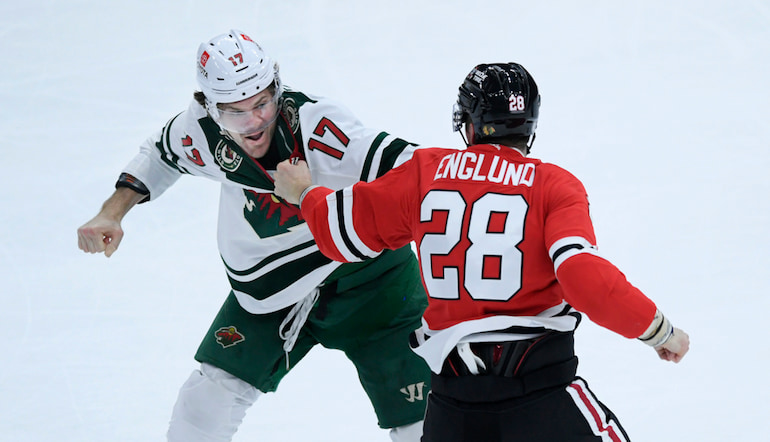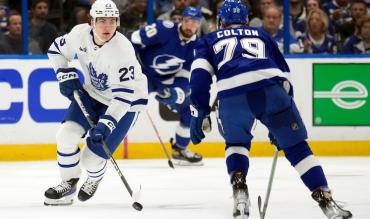A team sport that’s equal parts finesse, speed, physicality, and high-impact, it’s easy to see why ice hockey is such a popular sport in countries where the facilities are readily available.
Still, ice hockey isn’t as straightforward as simply getting the puck into the back of the net more times than the opposing team, so newcomers are often left wondering what the rules of ice hockey are.
In this guide, we’re breaking down all of the rules of ice hockey, its different phases, and everything that you need to know to understand what players are doing on the ice.
What Do the Lines on the Ice Hockey Rink Mean?
The lines on the ice hockey rink indicate goal lines, lines for offside, the centreline, and faceoff circles.
With a landscape bird’s eye view, to the left and right, you’ll see a goal line run through the net and to either side. The puck needs to pass this line into the goal to score, but the line also marks potential icing stoppages to either side of the net’s mooring.
Next, the bluelines. These mark the offensive end for each team while also operating as the stagnant mark for offside. A player on offence can’t pass a blueline before the puck.

In the middle, there’s a big red line. This is the centreline which marks the middle of the neutral zone between the two bluelines where player benches can skate on from the side, and where the opening faceoffs will be taken.
The dots on the rink, including those within the five circles, are faceoff spots. This is where the official will drop the puck when a faceoff needs to take place in the respective zone.
How Do Ice Hockey Shifts, Lines, and Units Work?
In ice hockey, teams are usually comprised of 20 players: 12 forwards, six defensemen, and two goaltenders. However, only five skaters and one goalie will be allowed on the ice at even-strength (before a penalty is called).
A team can use all of these players, and to organize this, head coaches create four lines of forwards and three lines of defensemen. Forward lines will rotate throughout the game, as will defensive pairs.
There are also units created to deal with situations that aren’t played at even-strength. This leads to teams having powerplay units to enhance their chance of scoring with a player-advantage, as well as penalty kill units that are designed to stop teams with a player-advantage from scoring.
A team can end up with more than five players on the ice at any one time if they’re given a play-on advantage following a foul or if they pull the goaltender to get an extra skater on the ice in place of the goalie.
Goaltenders can also be replaced during the game by the backup if they’re injured to the head coach sees them as having performed poorly.
Generally speaking, a team’s best forwards can look to average between 20 and 23 minutes on the ice per game, while top defensemen who’re suited to all situations can average between 25 and 29 minutes.
This is why, when looking at NHL betting, it’s important to consider a player’s lines and expected time on ice when backing player props, such as anytime point or goal scoring.
Often fluidly, coaches will roll their lines on and off of the ice when at even-strength and in the middle of penalty spells. Forward lines tend to get around 40 seconds before a line change, while defensive pairs get around one minute.
While the puck is in play, skaters will glide to the bench, enter through the gate, and when they’re in, the player replacing them will hop the wall and skate into action.
What are the Phases of an Ice Hockey Game?
Regular time in ice hockey sees two teams compete in three 20-minute periods. The clock only runs when the puck is in play, so there isn’t any added time. Between each period, the teams will switch sides.
However, if the score is tied at the end of the 60 minutes, in most competitions, there will be a usually-shortened period of overtime (sudden death rules), and if that doesn’t find a winner, there’ll be a shootout.

Most ice hockey leagues across North America and Europe are played in a league system followed by a playoff knockout tournament to determine the ultimate winner.
During each period, there will be several stoppages on the ice, including for the goalie freezing the puck, icing, penalties, the puck going out of play, and injuries.
What are the Causes of Stoppages in Ice Hockey?
The play and timer can be stopped in ice hockey for many reasons, as follows:
-
Icing: When a player in their half hits the puck into their offensive zone and the puck crosses the goal line. This can be negated by a teammate beating the opposition to the puck or by the goalie stopping the puck.
-
Offside Rule: A player is offside if the team moving into the offensive zone does so before the puck moves over their offensive zone blueline. This is ruled on the player’s skate, not their stick.
-
Out of Play: Sometimes, the puck will bounce out of the rink. In this case, the play stops and a faceoff will be taken in the nearest faceoff circle to where the puck left the rink.
-
Freezing the Puck: The goalie can freeze the puck to stop the play by putting a part of their body – usually their glove hand – over the puck to stop its movement.
-
Fouls and Penalties: Whenever a foul is committed, the referee will eventually stop the play to call the penalty.
What Penalties can be Called in Ice Hockey?
There are several forms of fouls in ice hockey that the referee will call as penalties, resulting in the player being put in the penalty box for a designated number of minutes and leaving their team at a player disadvantage.
However, before the play is stopped, if the aggrieved team still has the puck, they’ll get an additional player on the ice until they lose the puck, and then, the penalty gets called.
Minor penalties last for two minutes, and with only one minor penalty in play, results in 5-vs-4 hockey. Multiple minor penalties can be called for several players, causing 5-vs-3, 4-vs-4, and 3-vs-3 hockey.
If a goal is scored by the non-offending team during this time, the rest of the penalty minutes are wiped, and the player in the penalty box gets to be played again.
In the case of a double-minor penalty, the player is dealt four minutes in the penalty box. If a goal is scored, one of the two two-minute minor penalties gets erased from their spell off of the ice.

Major penalties tend to last for five minutes, which won’t be erased regardless of the number of goals scored by the team with the player-advantage as a result of the penalty call.
A major penalty that doesn’t see teams fall to a player-disadvantage is usually fighting. Both players who drop the gloves are equally at fault, get five minutes in the penalty box, but teams continue at 5-vs-5.
Finally, there are the game misconduct or automatic ejection penalties. These see the player endure much larger penalties and even get ejected from the game.
Whenever a team is dealt a penalty, their opponents get a significant advantage known as a powerplay. When this happens, the odds in the live betting online swing in favour of a goal for the team with a player-advantage.
Here’s a list of the penalties in ice hockey:
-
Tripping: Using the leg or stick to trip another player.
-
Roughing: Shoving or similar unnecessary play, often after the whistle.
-
Holding: Pulling on another player or their jersey.
-
Hooking: Using the blade of the stick to hinder another’s movement.
-
Elbowing: Forcedly throwing an elbow into another player.
-
Butt-Ending: Using the top of the stick to jab another player.
-
High-Sticking: Holding the stick above the waistline and using it to contact another player. This can become a double minor if blood is drawn.
-
Charging: Taking additional strides to gain extra momentum before laying a heavier-than-necessary body check.
-
Spearing: Essentially thrusting the stick in a stabbing-like movement into another player.
-
Slashing: Swiping the stick against another player.
-
Cross-Checking: Using the stick as a part of a body check.
-
Boarding: Making illegal contact that results in another player colliding with the boards around the rink.
-
Misconduct: Unsportsmanlike behaviour, verbal abusiveness, or game disruption can be called misconduct.
-
Holding the Puck: If a player catches the puck and doesn’t drop it immediately, it’ll result in a penalty.
-
Interference: Restricting a player who doesn’t possess the puck through contact.
-
Headbutting: Using one’s head to make contact with another in a deliberate way.
-
Delay of Game: Deliberately putting the puck out of the rink or deliberately moving the goal from its mooring.
-
Too Many Players: If there is more than the designated number of players for a team on the ice, a penalty is called.
-
Fighting: Two players agree to a fight by dropping their gloves, stopping the play for the referees to monitor the permitted fight.
It continues until the referees pull the players apart or a player ends up on the ice. Both are given at least five minutes in the penalty box.
-
Instigator (Fighting): The player who causes a fight by throwing the first punch, provokes another through verbal taunts, or drops their gloves when the other doesn’t do so.
-
Aggressor (Fighting): If a player fights another who stops engaging or is defenceless, they’ll be dealt a game misconduct and a major penalty.
Who are the Referees and Officials in Ice Hockey?
There can be a different count of officials on the ice in a hockey game, but in the NHL, there are two referees and two linesmen.
The referees call penalties, goals, and drop the puck for faceoffs. The linesmen watch the lines on the rink to call offside and icing infringements. Off of the ice, there will be timekeepers, goal judges, and an official scorer.
Those are the core ice hockey rules and how the sport works, so you should now be able to identify all of the actions that take place in any given game.
*Credit for all images in this article belongs to AP Photo*


